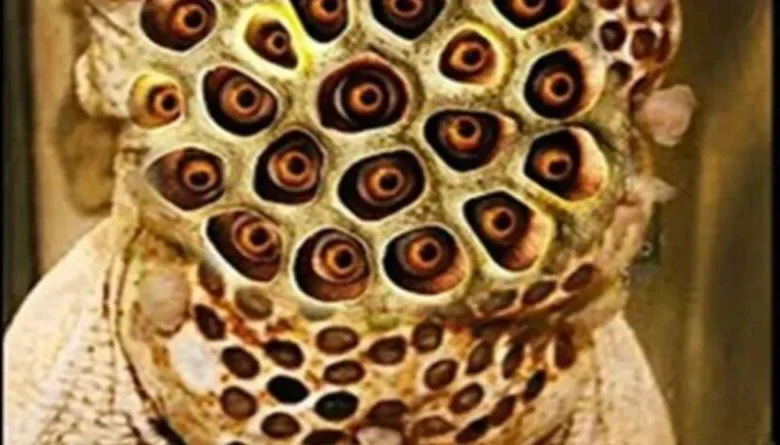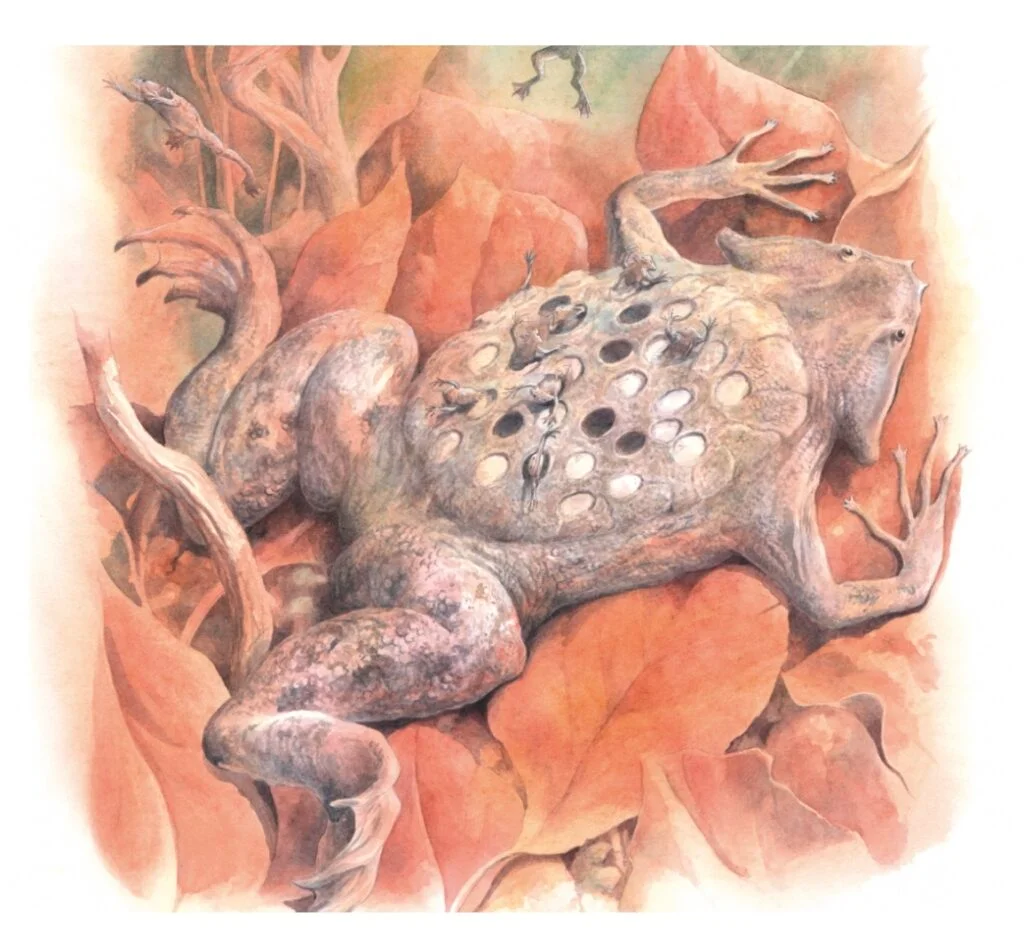
The common Surinam toad, the Suriname toad, or star-fingered toad (Pipa pipa), is a fully-aquatic species of frog, in the family Pipidae, with a widespread range across much of tropical South America and the island of Trinidad. The females of this species are well-known for “incubating” their eggs on their backs, in honeycomb-like depressions directly within the skin, releasing fully-formed froglets after a period of 4–5 months.
Pipa pipa is an ambush predator, lying in-wait underwater for prey to inevitably wander too close, swiftly inhaling the unsuspecting creature using suction feeding. Additionally, the Surinam toad’s rather flat body shape, combined with rather dark, dull coloration, serves as effective camouflage in the murky waters they inhabit, perfectly mimicking a dead leaf or piece of rotting wood as they await their next meal.
In one of the strangest birth methods in the animal species, babies erupt from a cluster of tiny holes in their mother’s back.

Pipa is a strictly aquatic frog and the largest member of its genus. The species has an exceptionally depressed body, almost entirely flat and with a broad, flat, triangular head. It is without a tongue. The body is similar in appearance to a mottled brown leaf. The feet are broadly webbed with the front toes having small, star-like appendages. Males can grow up to 154 mm long, whereas females can reach up to 171 mm. Females can be distinguished not only by their length but also by their ring-shaped cloacas, visible when they are ready to breed.
The skin color is mostly light brown with some darker spots on the back, providing good camouflage Nostrils are terminal, eyes very small, and the tympanum is missing. The limbs are in a laterally sprawled position in the plane of the body, and the fingertips are modified into four small lobes. Absence of a tongue prevents the species from capturing prey with that organ like most other frogs, and instead suction capture is used.
The skull is hyperossified and the cranial and postcranial bones are heavily modified compared to other anurans. While the eyes are relatively small and narrow, the species has a lateral line system and neuromast organs which are assumed to help it locate prey and predators.
The Surinam toad lacks dermal antimicrobial peptides that may inhibit disease agents such as chytridiomycosis and Ranavirus, which could make it slightly more susceptible to disease.
Habitat and distribution
The Surinam toad, despite its common name, is actually native to several South American countries; as well as Suriname, Additionally, a small population may be found in the southwestern corner of the island of Trinidad, just north of Venezuela across the Columbus Channel. Pipa pipa has the largest geographic distribution within its genus.
The Surinam toad inhabits warm, acidic, murky and slow-moving to still waterways, including streams, backwaters, ponds and seasonal pools after localized flooding; these rich waters often have a low pH due to a high concentration of organic matter and tannins.
It is so strongly adapted for an aquatic lifestyle that on land it is helpless and scarcely able to move.
Diet
The species is an omnivorous ambush hunter. Its diet consists mostly of invertebrates, such as worms, insects, crustaceans and small fish.
Field caught Pipa pipa have been found with erythrinid fish species, other small Pipa pipa, catfish, arthropods and amphibian skin in their stomachs.
One study found that Cyclopoida made up 67%, Diptera larvae 7.3%, and Heteroptera 6.3% of prey. The skin fragments that were found in their stomach are an indication that these frogs commit cannibalism or eat their own skin which is common among amphibians. Based on these results, P. pipa is an ambush predator that will opportunistically eat anything that falls into the water or that it may encounter when occasionally foraging on land.
Reproduction
The mating period of these frogs is during the fall and winter seasons. These frogs call usually during the morning and mid-afternoon hours.
Males of this species do not attract females with croaks, instead producing a sharp clicking sound by snapping the hyoid bone in their throats. The clicking sound resembles metallic noises. The average rate of these clicks is four clicks per second, consisting of blocks of 10 to 20 seconds per period.
Thereafter, the male will grab the front legs of the female in amplexus, causing the cloaca and the skin of the female to swell.
The partners rise from the floor while in amplexus and flip through the water in arcs. The couple will swim around in the water until they have to swim to the surface to breathe. Afterwards, they will swim back down to the bottom of the water. There the male will lay on his back, with the female on top of him on her stomach. During the amplexus, the female’s back is gradually swelled to a puffy condition. The male and female cloacae are brought close together, and many eggs are transferred anteriorly to the female’s swollen dorsal epidermis.






